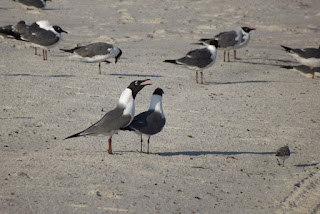How about a nice, long walk?
I find that strolling up and down a stretch of seashore helps me to
decompress. Any time of the year can be
good, but springtime is surely one of the most interesting seasons for avian
life—especially on the Mississippi coast.
It is late afternoon.
A lone Reddish Egret stalks fish in the cobalt waters. Its blue-gray body—with touches of white—and
rust-colored head and neck echo the tints of the waves. Found almost exclusively in coastal regions,
this species occurs in a white form as well as the more familiar “reddish”
morph. This individual appears almost
stately—perhaps it is wary of beach walkers—but Reddish Egrets are frequently
very lively foragers, darting back and forth and flicking their wings outward
to startle their prey.
 |
Reddish Egret
|
The egret isn’t the only wading bird braving the waves: a
trio of Marbled Godwits—migratory transients on the Gulf Coast—also feeds in
the surf. They’ll likely have moved on,
northward, in a month or two.
 |
| Marbled Godwits |
The same cannot be said for the ubiquitous Laughing
Gulls. These coastal residents remain here all year long, and are as opportunistic as they are common. Many people view Laughing Gulls as nothing
more than nuisances, but I think this is an unfair assessment of these long-lived
and clever birds. Like crows, raccoons,
and black bears, they have figured out how to exploit
human resources, and we hate them for it!
I don’t think the gulls are too concerned about this, however.
 |
| Laughing Gulls |
The Reddish Egret from earlier paces in front of the group
of gulls. Are the pickings better over
this way? Maybe, maybe not.
 |
| Reddish Egret and Laughing Gulls |
A Snowy Egret shows up to survey the surf for small
fish. As you can probably tell from the
photo, this species is considerably smaller than the Reddish Egret. Like its larger relative, it often displays a
particularly active foraging style, with lots of “dancing” in and out of the
waves. The larger wading birds, such as
Great Blue Herons and Great Egrets, tend to be more sedate in their hunting
behavior. This Snowy, however, mostly
stands still and makes itself compact, probably as protection from the wind.
 |
| Snowy Egret and Laughing Gulls |
Farther up the beach, a Ruddy Turnstone turns over … not a
stone, but a leaf. What is it finding in
the sand? Tiny insects? Possibly so—this is a fairly opportunistic
hunter. Like the Marbled Godwit, it’s a
species that breeds farther north. It
will probably migrate soon, but, in the meantime, it frequents the beaches with
other migratory shorebirds, flashing its stunning black-and-white wing patterns
whenever it flies up the shoreline in search of prey.
 |
| Ruddy Turnstone |
Tire tracks show where someone has driven an ATV up the
beach. Laughing Gulls, Black Skimmers, and a few Sanderlings congregate just past these markings, while Dunlin rest closer to the
dunes. They remind me of cattle, with
their (tucked-in) heads all turned in the same direction.
 |
| Beach birds |
 |
| Laughing Gulls and Sanderling |
 |
| Dunlin |
A close-up of snoozing Dunlin reveals subtle markings, which
would help to camouflage these birds in the sand and mud.
 |
| Dunlin markings |
Other migratory shorebird species on the beach sands are
Black-bellied Plovers and Willets. The
plovers are still mostly in drab winter plumage, but they’re showing signs of
molting into breeding plumage, in which they
will have black bellies. The
Willets are similarly dull and gray, since they haven’t finished molting into
their barred-and-mottled breeding plumage.
Willets are common all over the beaches at this time of year.
 |
| Black-bellied Plovers and Sanderlings |
 |
| Black-bellied Plover and Dunlin |
 |
| Willets and Laughing Gull |
Rounding out the beach bird community are Black
Skimmers. It’s still early enough in the day that
these crepuscular birds probably haven't made too many trips away from the shore. They will head out in larger numbers closer
to evening, when they fly low over the water and drag their ultra-long,
red-and-black bills along the surface to find fish to snap up. Right now, resting along the beach, they look
a bit odd and awkward, propped up on their stumpy legs and with their colossal bills
slanting downward. At
evening, however, their unusual adaptations will serve them well, making them highly efficient hunters.
 |
| Black Skimmers, Laughing Gulls, and Dunlin |
For a diurnal mammal like me, though, it’s about time to
turn in for the night. Since this is
spring, coming back to the beach later will likely mean reporting on a slightly
different group of birds—a unique mixture of resident species and transients—as
migration continues.














